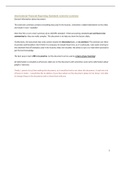Notes de cours
UvA Master A&C - Extensive Summary - International Financial Reporting Standards (IFRS) - Grade 7.6
- Cours
- Établissement
- Book
This document contains an overview of all lectures slides which are covered during the classes, furthermore I sometimes added more information about certain tables and examples. Note that this document does not contain seminars! It should be used as a base for your learning. Eventually you need to ...
[Montrer plus]





